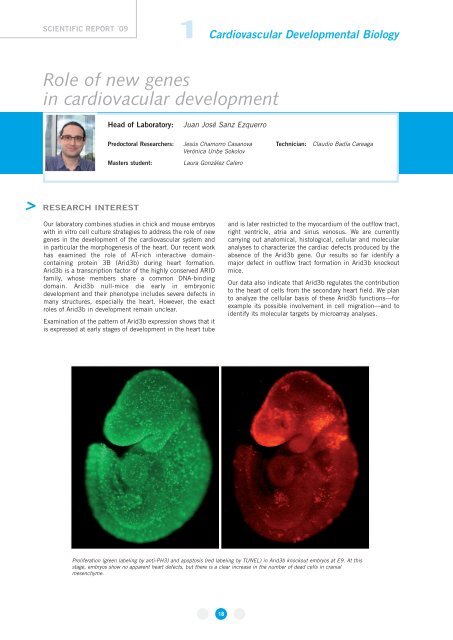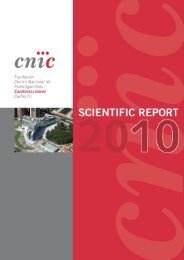Appendix - CNIC
Appendix - CNIC
Appendix - CNIC
Create successful ePaper yourself
Turn your PDF publications into a flip-book with our unique Google optimized e-Paper software.
SCIENTIFIC REPORT ´09 1 Cardiovascular Developmental Biology<br />
Role of new genes<br />
in cardiovacular development<br />
> RESEARCH INTEREST<br />
Head of Laboratory: Juan José Sanz Ezquerro<br />
Predoctoral Researchers: Jesús Chamorro Casanova<br />
Verónica Uribe Sokolov<br />
Masters student: Laura González Calero<br />
Our laboratory combines studies in chick and mouse embryos<br />
with in vitro cell culture strategies to address the role of new<br />
genes in the development of the cardiovascular system and<br />
in particular the morphogenesis of the heart. Our recent work<br />
has examined the role of AT-rich interactive domaincontaining<br />
protein 3B (Arid3b) during heart formation.<br />
Arid3b is a transcription factor of the highly conserved ARID<br />
family, whose members share a common DNA-binding<br />
domain. Arid3b null-mice die early in embryonic<br />
development and their phenotype includes severe defects in<br />
many structures, especially the heart. However, the exact<br />
roles of Arid3b in development remain unclear.<br />
Examination of the pattern of Arid3b expression shows that it<br />
is expressed at early stages of development in the heart tube<br />
Technician: Claudio Badía Careaga<br />
and is later restricted to the myocardium of the outflow tract,<br />
right ventricle, atria and sinus venosus. We are currently<br />
carrying out anatomical, histological, cellular and molecular<br />
analyses to characterize the cardiac defects produced by the<br />
absence of the Arid3b gene. Our results so far identify a<br />
major defect in outflow tract formation in Arid3b knockout<br />
mice.<br />
Our data also indicate that Arid3b regulates the contribution<br />
to the heart of cells from the secondary heart field. We plan<br />
to analyze the cellular basis of these Arid3b functions—for<br />
example its possible involvement in cell migration—and to<br />
identify its molecular targets by microarray analyses.<br />
Proliferation (green labeling by anti-PH3) and apoptosis (red labeling by TUNEL) in Arid3b knockout embryos at E9. At this<br />
stage, embryos show no apparent heart defects, but there is a clear increase in the number of dead cells in cranial<br />
mesenchyme.<br />
18



